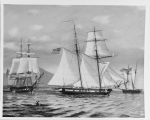Specifications:
Displacement 52 t.
Length unknown
Beam unknown
Depth of Hold unknown
Speed unknown
Complement 31
| Click On Image For Full Size Image |
Size | Image Description | Contributed By |
|
|---|---|---|---|---|

094611204 |
102k | Tommy Trampp | ||
 |
250k | "Fajardo Incident". An oil painting by RADM. John W. Schmidt showing frigate USS John Adams and schooners USS Grampus and USS Beagle off the east coast of Puerto Rico, 14 November 1824. US Naval History and Heritage Command Photo # NH 123338 |
US Naval History and Heritage Command | |
USS Beagle (I)
Dictionary of American Naval Fighting Ships (DANFS)
| Back To The Navsource Photo Archives Main Page | Back To The Old Navy" Steam and Sail Index |
| Comments, Suggestions, E-mail Webmaster. |
|
This page is created and maintained by Gary P. Priolo |